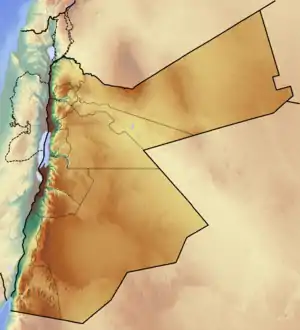Umm Irna Formation
The Umm Irna Formation is a geological formation in Jordan. It is found in several outcrops in Jordan in the area around the eastern shore of the Dead Sea. It is Late Permian (likely Changhsingian) in age, and is the oldest unit in the succession, overlying the Cambrian aged Umm Ishrin Sandstone Formation. The formation predominantly consists of sandstones, claystones and mudstones deposited in fluvial and lacustarine conditions.[1] The formation is of considerable paleobotanical interest, as it preserves the earliest known remains of plant groups that would become widespread during the Mesozoic, including Corystosperm seed ferns, represented by the widespread Triassic genus Dicroidium, Zamiineae cycads, podocarp conifers, as well as Bennettitales.[2] Other plant groups present in the formation include Noeggerathiales, gigantopterids and possible ginkgophytes.[2]
| Umm Irna Formation Stratigraphic range: Late Permian | |
|---|---|
| Type | Geological formation |
| Underlies | Ma'in Formation |
| Overlies | Unconformity with Umm Ishrin Sandstone |
| Thickness | 60–70 m (200–230 ft) |
| Lithology | |
| Primary | Claystone, siltstone, sandstone |
| Location | |
| Coordinates | 31.3°N 35.55°E |
| Country | |
| Extent | Several exposures along the eastern Dead Sea coast |
| Type section | |
| Named by | Bandel & Khoury |
| Location | Wadi Himara |
| Year defined | 1981 |
| Thickness at type section | 63 m (207 ft) |
 Umm Irna Formation (Jordan) | |
References
- Stephenson, Michael H.; Powell, John H. (2013-07-01). "Palynology and alluvial architecture in the Permian Umm Irna Formation, Dead Sea, Jordan". GeoArabia. 18 (3): 17–60. ISSN 1025-6059.
- Blomenkemper, Patrick; Kerp, Hans; Hamad, Abdalla Abu; DiMichele, William A.; Bomfleur, Benjamin (2018-12-21). "A hidden cradle of plant evolution in Permian tropical lowlands". Science. 362 (6421): 1414–1416. doi:10.1126/science.aau4061. ISSN 0036-8075. PMID 30573628.